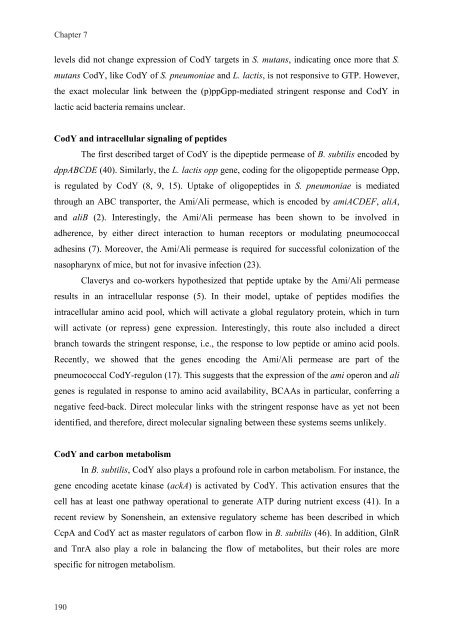Gene regulation in Streptococcus pneumoniae - RePub - Erasmus ...
Gene regulation in Streptococcus pneumoniae - RePub - Erasmus ...
Gene regulation in Streptococcus pneumoniae - RePub - Erasmus ...
Create successful ePaper yourself
Turn your PDF publications into a flip-book with our unique Google optimized e-Paper software.
Chapter 7<br />
levels did not change expression of CodY targets <strong>in</strong> S. mutans, <strong>in</strong>dicat<strong>in</strong>g once more that S.<br />
mutans CodY, like CodY of S. <strong>pneumoniae</strong> and L. lactis, is not responsive to GTP. However,<br />
the exact molecular l<strong>in</strong>k between the (p)ppGpp-mediated str<strong>in</strong>gent response and CodY <strong>in</strong><br />
lactic acid bacteria rema<strong>in</strong>s unclear.<br />
CodY and <strong>in</strong>tracellular signal<strong>in</strong>g of peptides<br />
190<br />
190<br />
The first described target of CodY is the dipeptide permease of B. subtilis encoded by<br />
dppABCDE (40). Similarly, the L. lactis opp gene, cod<strong>in</strong>g for the oligopeptide permease Opp,<br />
is regulated by CodY (8, 9, 15). Uptake of oligopeptides <strong>in</strong> S. <strong>pneumoniae</strong> is mediated<br />
through an ABC transporter, the Ami/Ali permease, which is encoded by amiACDEF, aliA,<br />
and aliB (2). Interest<strong>in</strong>gly, the Ami/Ali permease has been shown to be <strong>in</strong>volved <strong>in</strong><br />
adherence, by either direct <strong>in</strong>teraction to human receptors or modulat<strong>in</strong>g pneumococcal<br />
adhes<strong>in</strong>s (7). Moreover, the Ami/Ali permease is required for successful colonization of the<br />
nasopharynx of mice, but not for <strong>in</strong>vasive <strong>in</strong>fection (23).<br />
Claverys and co-workers hypothesized that peptide uptake by the Ami/Ali permease<br />
results <strong>in</strong> an <strong>in</strong>tracellular response (5). In their model, uptake of peptides modifies the<br />
<strong>in</strong>tracellular am<strong>in</strong>o acid pool, which will activate a global regulatory prote<strong>in</strong>, which <strong>in</strong> turn<br />
will activate (or repress) gene expression. Interest<strong>in</strong>gly, this route also <strong>in</strong>cluded a direct<br />
branch towards the str<strong>in</strong>gent response, i.e., the response to low peptide or am<strong>in</strong>o acid pools.<br />
Recently, we showed that the genes encod<strong>in</strong>g the Ami/Ali permease are part of the<br />
pneumococcal CodY-regulon (17). This suggests that the expression of the ami operon and ali<br />
genes is regulated <strong>in</strong> response to am<strong>in</strong>o acid availability, BCAAs <strong>in</strong> particular, conferr<strong>in</strong>g a<br />
negative feed-back. Direct molecular l<strong>in</strong>ks with the str<strong>in</strong>gent response have as yet not been<br />
identified, and therefore, direct molecular signal<strong>in</strong>g between these systems seems unlikely.<br />
CodY and carbon metabolism<br />
In B. subtilis, CodY also plays a profound role <strong>in</strong> carbon metabolism. For <strong>in</strong>stance, the<br />
gene encod<strong>in</strong>g acetate k<strong>in</strong>ase (ackA) is activated by CodY. This activation ensures that the<br />
cell has at least one pathway operational to generate ATP dur<strong>in</strong>g nutrient excess (41). In a<br />
recent review by Sonenshe<strong>in</strong>, an extensive regulatory scheme has been described <strong>in</strong> which<br />
CcpA and CodY act as master regulators of carbon flow <strong>in</strong> B. subtilis (46). In addition, GlnR<br />
and TnrA also play a role <strong>in</strong> balanc<strong>in</strong>g the flow of metabolites, but their roles are more<br />
specific for nitrogen metabolism.

















